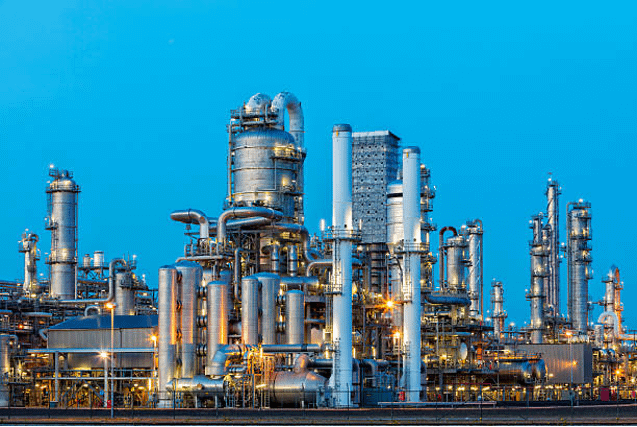Petrochemical plants are facilities made for the processing of chemicals made from petroleum. Petrochemicals are utilized in everything from fuel to industry and are incredibly adaptable which leads us to question, what is a petrochemical plant?
What are Petrochemicals and what are their uses?
Derived from petroleum, petrochemicals are chemical products obtained from natural gases, oils, and fossil fuels such as coal. They’ve been used in production since the 1940s.
Crude oil is the foundational component used for petrochemical and petroleum production, which undergoes refinement in oil refineries.
Petrochemicals are widely used to their convenience in cost and their limited impact on the environment. They are omnipresent in our most purchased items, including plastics, fertilizers, packaging, clothing, digital devices, tires, cosmetics, and other crucial parts of our modern societies, such as medical equipment and infrastructural parts.

Petrochemical Plant VS Refinery
Let us compare petrochemical plants and refineries:
| Petrochemical Plants | Refinery |
| Petrochemical Plants are used in the production of petrochemicals made from refineries. Refineries “feed” petrochemicals plants with raw materials including:
– Olefins, essential to produce plastics and synthetic rubber, – Aromatics include benzene, toluene, and xylenes which are widely used in plastics and synthetic fibers, – Synthesis gas is a mixture of carbon monoxide and hydrogen. |
An oil or petroleum refinery is the industrial process of transforming crude oil into petroleum products to be later used as fuels for transportation, heating, and chemical production (i.e., raw materials used in the petrochemical industry). |
Petrochemical Plant Components
Petrochemical Plants execute the transformation of natural resources into productions of commodities with various purposes. These facilities are complexes with many components, these include:
- Ethylene cracking furnaces, are a crucial piece of equipment where raw materials are converted into ethylene (i.e., a fundamental petrochemical) and valuable by-products,
- Plate-fin heat exchangers, are a key component in many process plants,
- Packaged units / cold boxes, treat cryogenic fluid and gases. These units contain a series of components, including columns, plate-fin heat exchangers, pressure vessels,
- Pressure swing adsorption, recover and purify hydrogen,
- Incinerators dispose of gaseous waste generated by chemicals,
- Cryogenic tanks are used to process metal, medical technology, electronics, and more.
Petrochemical Waste Plant
Waste is inherent to oil industries and petrochemical production. Petrochemical plants mainly generate wastewater that can be traced to oilfield production, crude oil, and refinery plants. This wastewater can be composed of various chemical sources.
Treating petrochemical wastewater is specific to its chemical components. These specificities determine discharge requirements and treatment efficiencies. These types of treatments can be physical (chemical absorption) or chemical (changing chemical components to change wastewater composition).
Quantum Petrochemical Plant Services
Petrochemical Plant services can include:
- Petrochemical maintenance or turnaround planning, which allows defining projects scope and development, cost estimates, and other project-related details,
- Petrochemical inspection services can involve contracting, safety management, testing, and project execution monitoring,
- Petrochemical field services involve towers, pressure vessels, exchangers, power piping, and heaters.
New Petrochemical Projects in Egypt
Since 2021, Egypt has invested $ 14 billion into petrochemical projects. These projects include:
- MIDOR refinery expansion, aiming to grow refining capacity by 60 thousand barrels per day,
- Red Sea Petrochemical Company production units’ construction to produce high-quality petrochemical products,
- ANPEC’s diesel conversion of low economic value into high-quality petroleum products project
- Anchorage Investments’ Anchor Benitoite petrochemical project in Suez includes the construction of production facilities. .
Petrochemical Plant Latest News
The petrochemical industry is constantly expanding. Let’s look at the more recent news related to petrochemical plants worldwide:
- South Korea: S-Oil refiner initiates their Shaheen project complex that will produce up to 3.1 million mt/year of petrochemical feedstocks. The launching ceremony was attended by the South Korean President and Aramco business leaders.
- United States: a petrochemical plant in Alvin, Texas is looking to fill its wide range of positions and increase the percentage of women working in the facility to limit the gender gap,
- S & Qatar: Qatar Energy and Chevron Phillips Chemical partner to produce an $8.5 billion Golden Triangle plant in Orange County, Texas.
To conclude, Petrochemicals are mainly produced from crude oil, which is derived from refineries that transform oils into petroleum products.
The petrochemical industry is continuously growing worldwide, with new petrochemical projects and advancements being made in, but not limited to the U.S. and South Korea.
Petrochemical production units are built with various components allowing their efficient functioning. Their production process inherently produces wastewater treated to its specific chemical components resulting from the petrochemical produced.
The petrochemical plants supply chain provides many services, such as maintenance and field service.
So, what is a petrochemical plant? These facilities work to produce petrochemicals and their derivatives to create later essential commodities in medical, commercial, automotive, renewable energy production, and more. Egypt has been heavily investing in petrochemical projects since 2021, noting that they are cost-effective and have the least environmental damage.
